
Page 18: of Marine News Magazine (April 2017)
Boatbuilding: Construction & Repair
Read this page in Pdf, Flash or Html5 edition of April 2017 Marine News Magazine
COLUMN BOATBUILDING FINANCE
The 2007 Act: “Highways to Waterways”
By H. Clayton Cook
The Energy Independence and Secu- mestic non-contiguous (Alaska, Hawaii and Puerto Rico) rity Act of 2007 (the 2007 Act) autho- trades. No other domestic trades were included. The 2007 rized a Short Sea Transportation (SST) Act expanded the domestic qualifying trades to include the program. As passed by the House, the carriage of “cargoes contained in intermodal cargo contain- legislation would have authorized $2 ers loaded on the vessel by crane” and “cargoes loaded on billion for the Maritime Administra- the vessel by means of wheeled technology” in all coastwise tion (MARAD) Title XI program and and inland river services nation-wide. have extended the Capital Construc- Now, more than 46 years since its 1970 Act passage, tion Fund Program (CCF or Program) the Program has been highly successful. All U.S. citizen
Cook to shipyards and operators building owners of signi? cant Jones Act qualifying trades ? eets are and operating vessels in SST services enrolled. At 2015 year-end deposits totaled approximately nationwide. Mr. Oberstar and his Congressional co-spon- $2.2 billion from 147 Program participants. Particular ad- sors were con? dent that with their proposals in place, the vantages include: much-discussed use of U.S. waterways for the transporta- tion of freight and passengers by water (“From Highways • Deferring tax: to Waterways”) would be underway. While retaining the The CCF Program allows a Participant to defer tax by de-
SST terminology for MARAD CFR regulations, MARAD positing earnings with a MARAD approved ? nancial insti- now more generally refers to the SST program as the tution Depository. The Participant commits to a program “America’s Marine Highway (AMH)” program. of vessel construction and MARAD commits the United
The 2007 Act gave MARAD the authority to add U.S. States to defer tax on monies deposited to ? nance these citizen shipyards and operators in the SST/AMH coastal projects. Unlike federal income tax bene? ts under the In- and inland waterways trades as CCF Program “quali? ed ternal Revenue Code, the Program tax bene? ts are contrac- vessel” participants. In the decade that has followed, not tual, as agreed by MARAD and the Participant. MARAD a single U.S. citizen shipyard, and only one U.S. citizen administers the Program under regulations that provide operator has sought to access this CCF Program opportu- the rules for participation, the sources and measures for nity. Why? deposits, the timing and accounting for withdrawals, and other Agreement matters. The Internal Revenue Service’s
MARAD CCF P role is detailed in the MARAD/IRS Joint Regulations that
ROGRAM
The CCF Program authorized by Merchant Marine govern a limited number of ? ling and accounting issues.
Act of 1970 (1970 Act) enables a U.S. shipyard, or ship A shipyard may make deposits representing shipbuilding owner or operator, to defer the payment of federal (and in pro? ts, and a vessel owner or operator may make deposits most instances state) income taxes on the pro? ts from U.S. representing chartering and operating income. The Par- vessel construction, vessel operations and sales, and vessel ticipant’s taxable income is reduced by the amount placed leasing, and on investment income on its Program depos- in the CCF account. The Participant remains the owner its. The Program provides what is in effect an interest free of the deposited funds and manages their investment itself loan (from the federal and state taxing jurisdictions) of the or with an investment advisor. The Participant then later money that would otherwise be paid to settle federal and withdraws funds from its CCF account to construct or ac- state taxes, in exchange for the taxpayer’s promise to use quire or reconstruct a quali? ed vessel. These withdrawals that money for the construction of vessels for operation in are not subject to income tax liability, but there is a down- “qualifying trades.” ward adjustment in the tax basis of the vessel for which the
As de? ned in the 1970 Act these “qualifying trades” monies are used. were the U.S. foreign and Great Lakes trades, and U.S. do- The tax bene? t begins when the taxpayer’s deposit is
April 2017
MN 18

 17
17

 19
19
